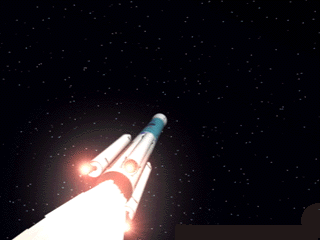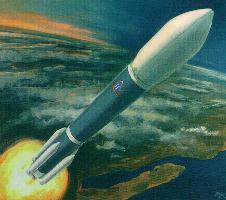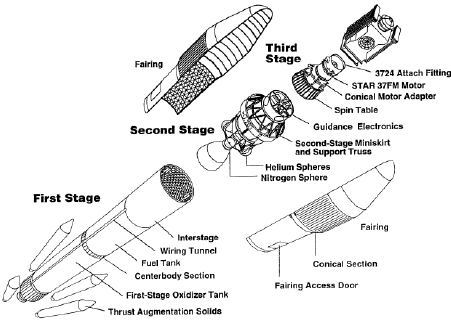| |||
|
|
|||
 | |||

STARDUST Launch Vehicle - The Delta II Rocket


The Stardust spacecraft was launched on a version of the Boeing Delta II launch vehicle known as a Delta 7425. The vehicle is similar to the 7925, a more powerful version of the Delta II used for NASA's Near Earth Asteroid Rendezvous (NEAR), Mars Pathfinder and Mars Global Surveyor missions. The major difference between these is that the Stardust vehicle used four strap-on solid rocket boosters instead of maximum of nine, since it was a relatively light spacecraft didn't require the additional thrust.
Boeing Delta II website:
http://www.boeing.com/defense-space/space/delta/delta2/delta2.htm

Each of the four solid rocket motors is 1 meter (3.28 feet) in diameter and 13 meters (42.6 feet) long. Each contains 11,765 kilograms (25,937 pounds) of hydroxyl-terminated polybutadiene (HTPB) propellant and provides an average thrust of 446,023 newtons (100,270 pounds) at sea level. The casings on the solid rocket motors are a lightweight graphite epoxy.
The second stage is 2.4 meters (8 feet) in diameter and 6 meters (19.7 feet) long, and powered by an AJ10-118K engine. The propellant is 5,900 kilograms (13,000 pounds) of Aerozine 50 (A-50), a mixture of hydrazine and unsymmetrical dimethyl hydrazine (UDMH), and nitrogen tetroxide as the oxidizer. This engine is restartable, and will perform two separate burns during the launch.
The third and final stage of the Delta 7425 is a Thiokol Star 48B booster, the same final stage used in the 1996 launch of Mars Global Surveyor. The Star 48B measures 2.12 meters (84 inches) long and 1.2 meters (4 feet) wide. Its motor carries solid propellant composed of a mixture of aluminum, ammonium perchlorate and hydroxyl-terminated polybutadiene (HTPB) solid propellant.
History of the Delta Rocket
The Delta II is a medium capacity expendable launch vehicle derived from the Delta family of rockets that have been built and launched since 1960. Its roots go back to the days immediately following the launch of Sputnik in 1957, when the Boeing modified its U.S. Air Force intermediate-range ballistic missile, the Thor, into a booster for Earth-orbiting satellites.
NASA's first satellite launch attempt on board Delta was Echo I in May 1960. Although it was not successful, the launch of NASA's Echo IA satellite August 12, 1960, started Delta on its way to becoming "NASA's workhorse." Until the early 1980s the Delta vehicles increased in size and capability, serving as NASA's primary launch vehicle for placing communications, weather, scientific and planetary exploration satellites into orbit.
After 24 years, Delta production came to a halt as NASA planned to launch subsequent satellites with the Space Shuttle. However, in January 1986 the Shuttle Challenger tragedy brought an announcement from President Ronald Reagan that shuttles would no longer carry commercial payloads, opening the way for the return of Delta.
A major contract to produce and launch 20 medium launch vehicles for the U. S. Air Force, beginning in 1989, brought the Delta production line back into full swing - this time involving a larger, more powerful Delta II. The U.S. Air Force contract was the catalyst necessary to market Delta commercially.
Over the years needs have changed, and Delta became larger, more advanced and capable of carrying heavier satellites into orbit. Design changes include a 12-foot extension in the first-stage tanks increasing propellant capacity, an improved main engine, adoption of advanced electronics and guidance systems, and development of upper stage and satellite payload.
Rocketdyne website:
http://www.boeing.com/space/rdyne/
During its lifespan variations of two main engines, both built by Rocketdyne, a division of The Boeing Company, have carried Delta aloft. From 1960 to 1974 the MB-3 powered the rocket; since then the RS-27 has been the main engine. Three strap-on solid rocket boosters were added to the Delta in 1964, and later the number increased to six.


| Webmaster: Ron Baalke |
